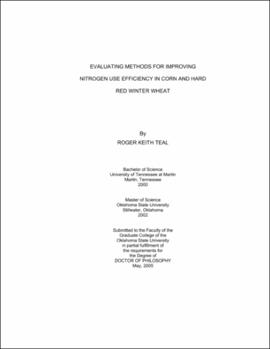| dc.contributor.advisor | Raun, William | |
| dc.contributor.author | Teal, Roger Keith | |
| dc.date.accessioned | 2013-12-10T18:04:39Z | |
| dc.date.available | 2013-12-10T18:04:39Z | |
| dc.date.issued | 2005-05 | |
| dc.identifier.uri | https://hdl.handle.net/11244/7751 | |
| dc.description.abstract | Scope and Method of Study: For chapter one, Corn (Zea mays L.) experiments were conducted to evaluate spectral reflectance, measuring the normalized difference vegetation index (NDVI) with a GreenSeeker Hand Held optical reflectance sensor as a function of hybrid, plant population, and fertilizer N rate. In the spring of 2004 with the addition of a third site and the availability of a green NDVI sensor, the trials were reconfigured removing one hybrid and imposing two more plant populations and the utilization of both green and red NDVI. Differences in NDVI, grain yield, grain N, and grain N uptake were investigated based on hybrid, plant population, and N rate. For chapter two, Hard red winter wheat (Triticum aestivum L.) experiments were conducted to evaluate tillage system and anhydrous ammonia application methods on yield, N uptake, and NUE, using a narrow (10 cm) nozzle spacing on a V-blade (Noble or sweep blade) applicator and wide (46 cm) nozzle spacing on a knife applicator. | |
| dc.description.abstract | Findings and Conclusions: For chapter one, the critical population at which NDVI was no longer affected occurred between 55,000 and 60,000 plants ha -1 for the later maturing hybrids and closer to 70,000 plants ha -1 for the earliest maturing hybrids. Vegetative response index (RINDVI) at V8 was highly correlated with RI at harvest (RIHARVEST) in 2004. The V8 growth stage was most effective growth stage to predict grain yield. Hybrid maturity did not effect grain yield prediction at V8 and no significant differences occurred between the GNDVI and RNDVI relationships with grain yield in 2004. For chapter two, conventional tillage was significantly higher in grain yield and grain N uptake in five of eight site years over no-till. Mixed results were evaluated from NUE for tillage; four site years split evenly between conventional till and no-till. The V-blade improved NUE in no-till three site years at Lahoma, but the knife applicator increased NUE the initial year at Efaw in no-till. Previous crop residue disturbance averaged less than 15% for both AA applicators all four site years. No-till crop production reduced soil compaction at Efaw and the V-blade applicator reduced soil compaction within the no-till at both locations. | |
| dc.format | application/pdf | |
| dc.language | en_US | |
| dc.rights | Copyright is held by the author who has granted the Oklahoma State University Library the non-exclusive right to share this material in its institutional repository. Contact Digital Library Services at lib-dls@okstate.edu or 405-744-9161 for the permission policy on the use, reproduction or distribution of this material. | |
| dc.title | Evaluating methods for improving nitrogen use efficiency in corn and hard red winter wheat | |
| dc.contributor.committeeMember | Johnson, Gordon V. | |
| dc.contributor.committeeMember | Solie, John B. | |
| dc.contributor.committeeMember | Zhang, Hailin | |
| osu.filename | Teal_okstate_0664D_1299 | |
| osu.accesstype | Open Access | |
| dc.type.genre | Dissertation | |
| dc.type.material | Text | |
| thesis.degree.discipline | Plant and Soil Sciences | |
| thesis.degree.grantor | Oklahoma State University | |
